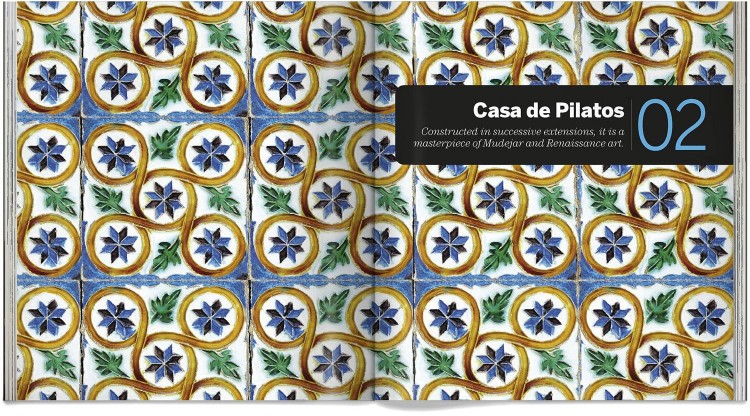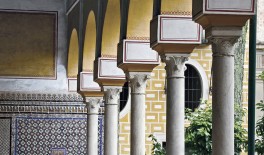Casa de Pilatos
The palace of the chief governors of Andalusia
RETURN
About the book Casa Pilatos
Constructed between the 15th and 16th centuries, Casa de Pilatos is the largest private palace in Seville. Owing to its singular design, in which elements of Mudejar and Renaissance style combine, this site is considered one of the most striking monuments in Spain.
The origin of the Casa de Pilatos goes back to the 1483, the year in which Pedro Enríquez, Chief Governor of Andalucia, built his residence on an old property of Islamic influence located in the centre of Seville. With the passing of the years, the palace was subject to various extensions, incorporating new spaces with decorative details in tune with the aesthetic preferences of each period.
This book dedicated to Casa de Pilatos, published by Dosde, shows in a comprehensive way the origins and the historical evolution of this masterpiece of Mudejar and Renaissance art. When turning its pages the reader will discover the role the palace's different inhabitants carried out, as well as the more characteristic corners of this unique monument, converted into one of the major icons of Seville.
The origin of the Casa de Pilatos goes back to the 1483, the year in which Pedro Enríquez, Chief Governor of Andalucia, built his residence on an old property of Islamic influence located in the centre of Seville. With the passing of the years, the palace was subject to various extensions, incorporating new spaces with decorative details in tune with the aesthetic preferences of each period.
This book dedicated to Casa de Pilatos, published by Dosde, shows in a comprehensive way the origins and the historical evolution of this masterpiece of Mudejar and Renaissance art. When turning its pages the reader will discover the role the palace's different inhabitants carried out, as well as the more characteristic corners of this unique monument, converted into one of the major icons of Seville.
Visual Edition
Casa de Pilatos
It includes exclusive digital content
Made with environmentally friendly paper
Official licensed product
Multilanguage: Available in 3 languages
About the book Casa Pilatos
Constructed between the 15th and 16th centuries, Casa de Pilatos is the largest private palace in Seville. Owing to its singular design, in which elements of Mudejar and Renaissance style combine, this site is considered one of the most striking monuments in Spain.
The origin of the Casa de Pilatos goes back to the 1483, the year in which Pedro Enríquez, Chief Governor of Andalucia, built his residence on an old property of Islamic influence located in the centre of Seville. With the passing of the years, the palace was subject to various extensions, incorporating new spaces with decorative details in tune with the aesthetic preferences of each period.
This book dedicated to Casa de Pilatos, published by Dosde, shows in a comprehensive way the origins and the historical evolution of this masterpiece of Mudejar and Renaissance art. When turning its pages the reader will discover the role the palace's different inhabitants carried out, as well as the more characteristic corners of this unique monument, converted into one of the major icons of Seville.
The origin of the Casa de Pilatos goes back to the 1483, the year in which Pedro Enríquez, Chief Governor of Andalucia, built his residence on an old property of Islamic influence located in the centre of Seville. With the passing of the years, the palace was subject to various extensions, incorporating new spaces with decorative details in tune with the aesthetic preferences of each period.
This book dedicated to Casa de Pilatos, published by Dosde, shows in a comprehensive way the origins and the historical evolution of this masterpiece of Mudejar and Renaissance art. When turning its pages the reader will discover the role the palace's different inhabitants carried out, as well as the more characteristic corners of this unique monument, converted into one of the major icons of Seville.
Readers opinions
(10)
RETURN
Reviews
(10)
Everything great, a carefully edited and detailed book on Casa de Pilatos.
Very satisfied with my purchase, thank you.
Very good book with excellent photos.
A perfect purchase. The illustrations and graphics are very good, also the content is of a high quality and detailed
It covers each theme in depth and the quality of the photos and texts is high.
The book's content is very good. Excellent photographs, very complete infographics...
Good photos and a lot of information about the Casa Pilatos.
They seem to be, for those who are lovers of art and architecture, particularly the layman, the best books that I know of to be informed in a very visual and simple way, with extraordinary infographics of famous buildings. Maybe the only criticism that I could make is that, at times, there could be less pictures with an amplification of the content of the book with regards to the historical context of the construction of the buildings, architect's biography, etc. I understand that the book needs to be easy to read, educational and visual and not overload the reader with “academic” text and I believe it is managed very well but the text could be padded out a little bit more.
The book's content is very thorough and covers every building in great detail. A great purchase.
Excellent books, very complete and perfect for the public they are designed for.
Readers opinions
(10)
Everything great, a carefully edited and detailed book on Casa de Pilatos.
Very satisfied with my purchase, thank you.
Additional Information
- Additional Information
- Subtitle: The palace of the chief governors of Andalusia
- Weight (g): 325
- Binding: Paperback with flaps
- Size (cm): 17,5 x 19,5
- Author: Dosde
- Pages: 0
- Edition: Visual Edition
Casa Pilatos, a great palace in Seville
Casa de Pilatos' developers were Don Pedro Enríquez, chief governor of Andalusia, and his second wife, Doña Catalina de Ribera, who, on acquiring in the late 15th century several sites confiscated by the Inquisition in the centre of Seville, to the north-east of the cathedral, planned to build a palace worthy of the union of two great lineages.
Constructed between 1483 and 1571 in successive extensions, it is a masterpiece of Mudejar and Renaissance art, which has been the object of study in numerous art and architecture books on Seville.
Visiting Casa Pilatos in Seville allows us to get to know a palace that combines Mudejar and Renaissance elements that provide great artistic value to the building. The main courtyard is one of the places in which this coexistence of styles in Sevillian architecture from the early 16th century.
This Sevillian palace has one of the largest tile collections in the world. In Casa de Pilatos more than 150 different tile designs can be made out, classified according to their decorative motifs and their source of inspiration.
Constructed between 1483 and 1571 in successive extensions, it is a masterpiece of Mudejar and Renaissance art, which has been the object of study in numerous art and architecture books on Seville.
A visit to Casa Pilatos
More than 10,000 square metres is the total surface area of the rooms, patios and gardens of Casa de Pilatos. Located in the centre of Seville, Casa de Pilatos –the Palace of the Chief Governors of Andalusia– is the result of more than ten acquisitions of properties and sites between 1483 and 1530, a process which led to an arrangement of buildings of great diversity in size and which converted the house into the largest private palace in Seville and second in the city after the Royal Alcazar.Visiting Casa Pilatos in Seville allows us to get to know a palace that combines Mudejar and Renaissance elements that provide great artistic value to the building. The main courtyard is one of the places in which this coexistence of styles in Sevillian architecture from the early 16th century.
This Sevillian palace has one of the largest tile collections in the world. In Casa de Pilatos more than 150 different tile designs can be made out, classified according to their decorative motifs and their source of inspiration.

































